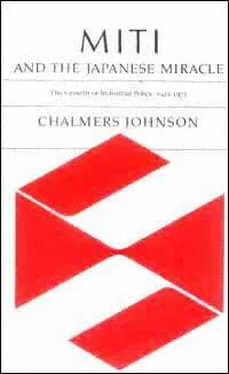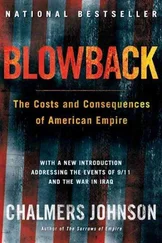Chalmers Johnson - MITI and the Japanese miracle
Здесь есть возможность читать онлайн «Chalmers Johnson - MITI and the Japanese miracle» весь текст электронной книги совершенно бесплатно (целиком полную версию без сокращений). В некоторых случаях можно слушать аудио, скачать через торрент в формате fb2 и присутствует краткое содержание. Год выпуска: 2007, Издательство: Stanford University Press, Жанр: Старинная литература, на английском языке. Описание произведения, (предисловие) а так же отзывы посетителей доступны на портале библиотеки ЛибКат.
- Название:MITI and the Japanese miracle
- Автор:
- Издательство:Stanford University Press
- Жанр:
- Год:2007
- ISBN:нет данных
- Рейтинг книги:3 / 5. Голосов: 1
-
Избранное:Добавить в избранное
- Отзывы:
-
Ваша оценка:
- 60
- 1
- 2
- 3
- 4
- 5
MITI and the Japanese miracle: краткое содержание, описание и аннотация
Предлагаем к чтению аннотацию, описание, краткое содержание или предисловие (зависит от того, что написал сам автор книги «MITI and the Japanese miracle»). Если вы не нашли необходимую информацию о книге — напишите в комментариях, мы постараемся отыскать её.
MITI and the Japanese miracle — читать онлайн бесплатно полную книгу (весь текст) целиком
Ниже представлен текст книги, разбитый по страницам. Система сохранения места последней прочитанной страницы, позволяет с удобством читать онлайн бесплатно книгу «MITI and the Japanese miracle», без необходимости каждый раз заново искать на чём Вы остановились. Поставьте закладку, и сможете в любой момент перейти на страницу, на которой закончили чтение.
Интервал:
Закладка:
46
During the autumn of 1946, when the subsidies finally ground to a halt, the economy virtually collapsed. Yamamoto Takayuki and Tokunaga Hisatsugu of MCI, together with Inaba Hidezo* of the ESB, put forward their famous thesis of a "March crisis"their prediction that by March of 1947 the Japanese economy would no longer be producing anything due to an exhaustion of stockpiles, a lack of imports, and an acute coal shortage. On November 5,1946, in order to forestall this, Prime Minister Yoshida established a personal brain trust known as the "Coal Committee" to tell him what to do. Its chairman was Arisawa Hiromi, and its members included Inaba Hidezo (formerly of the CPB), Okita* Saburo* (foreign minister in the Ohira* cabinet of 197980), Tsuru Shigeto (Harvard-trained economist and author in
Page 182
TABLE
11
Directors of the Economic Stabilization Board August 1946August 1952
Director and tenure
Remarks
Zen Keinosuke, 8/461/47
Former MAC-MCI bureaucrat.
Ishibashi Tanzan, 1/473/47
Concurrently finance minister.
Takase Sotaro *, 3/475/47

President, Tokyo Commercial University. MITI minister, 1950.
Wada Hiroo, 6/473/48

Former agriculture bureaucrat. Arrested in Cabinet Planning Board incident, 1941.
Kurusu Takeo, 3/4810/48
Arrested in Showa* Denko* scandal, 10/48.
Izumiyama Sanroku, 10/4812/48
Former Mitsui Bank official.
Shuto* Hideo, 12/482/49

Former agriculture bureaucrat. Former director, Department Four, Cabinet Planning Board (1942).
Aoki Takayoshi, 2/496/50

Former professor (economics), Nihon University.
Shuto Hideo, 6/508/52
See above.
1947 of Japan's first
Economic White Paper
), Sato* Naokuni (of MCI), Oshima* Kan'ichi (of the Finance Ministry), and several staff aides such as Kojima Keizo* (formerly of the CPB and at the time working in MCI's Coal Agency). This group invented "priority production" (
keisha seisan
). On January 31, 1947, in a cabinet reshuffle, Ishibashi Tanzan was asked to take on the post of director of the ESB in addition to serving as minister of finance, and he made priority production the central objective of the ESB (for a list of the ESB leaders, see Table 11).
Priority production was a scheme to concentrate all of the economy's assets in a few strategic sectors, regardless of the effects this might have on civilian consumption or inflation. In this respect it was quite similar to the revised materials mobilization plan of 1938. The Arisawa committee had recognized that the first objective had to be to increase coal production. Calculating from the 1946 production figure of 22.8 million tons, the committee had set a goal of 30 million tons for 1947. In order to try to achieve this, it had suggested that the coal industry get first priority on RFB loans and subsidies. Allocation of coal was an equally serious problem. Before the war 60 percent of coal output had been used by industry and only 40 percent for transportation, electricity generation, and other so-called civilian uses, but in 1946 these proportions were reversed. Demand for nonindustrial use had become so great that there was no possibility of reviving industry unless coal production was increased. The committee therefore earmarked 16 million of its targeted 30 million tons for industry, and the
Page 183
ESB was authorized to implement the Supply and Demand Law to achieve this distribution. Because the coal industry was a big steel user and steel production was itself dependent on coal, the committee designated steel as a second priority industry. It finally added fertilizer, which also uses coal, in order to try to expand food production.
Priority production was put into effect during the spring of 1947. Under Ishibashi's leadership and SCAP's orders that all ministerial planning functions be transferred to it, the ESB came to life. By May it had grown from a unit with 5 bureaus and 316 employees into a virtually new unit with a secretariat, 10 bureaus, 48 sections, and over 2,000 employees. MCI supplied the largest number of these new recruits. At the same time, the Diet enacted one law after another setting up the government corporations (kodan *) that under ESB orders purchased all major commodities from their producers at high prices and sold them to consumers at low prices, covering the difference with price subsidies from the general account budget. Table 12 summarizes the government's payments of subsidies and indemnities through the 1940's. It reveals that between 1946 and 1949 some 20 to 30 percent of all expenditures from the general account budget went to industry to cover operating costs and priority production.
SCAP liked the new economic institutions and the fact that the ESB had finally achieved authority (the Americans assumed that the real inspiration for the ESB was a comparable bureau they had set up in 1943 to supervise their own war economy), but SCAP still did not like the indifference to inflation of ESB Director Ishibashi.
47
It therefore purged him. Several observers on the scene at the time have suggested that Yoshida got rid of Ishibashi as a political rival by suggesting his name to General Whitney as an appropriate purgee, even though Ishibashi's prewar and wartime career as president of the
Oriental Economist
Publishing Company (Toyo* Keizai Shimposha*) had much less to do with the war effort than Yoshida's own activities. Whatever the case, Yoshida and Ishibashi became political enemies. Ishibashi did not return to the government until December 1954, when he became MITI minister in the Hatoyama cabinet and proceeded to dismantle the restraints placed on the ministry by Yoshida's Foreign Office appointments.
48
Shortly after Ishibashi's purge, the first Yoshida government fell and was replaced by the socialist cabinet of Katayama Tetsu. The Katayama cabinet continued and accelerated priority production, even though it no longer used that term since SCAP did not like it. The year from mid-1947 to mid-1948 was the high tide of priority production, during which the ESB, MCI, the Coal Agency, the kodan, and
Page 184
TABLE
12
Government Payments of Price Subsidies and Indemnities, 19401952
(Million yen)
Year

Total general account budget expenditures
Price subsidies (
kakaku
chosei
*
hi
)
Indemnities for losses (
sonshitsu
hosho
*
hi
)
1940
5,856
(100%)
17
(0.3%)
60
(1.0%)
1941
7,929
(100)
95
(1.2)
55
(0.7)
1942
8,271
(100)
305
(3.7)
240
(2.9)
1943
12,491
(100)
510
(4.1)
265
(2.1)
1944
19,872
(100)
1,266
(6.4)
567
(2.8)
1946
115,207
(100)
3,731
(3.2)
22,661
(20.0)
1947
205,841
(100)
28,178
(13.7)
8,566
(4.2)
1948
461,974
(100)
93,118
(20.2)
16,632
(3.6)
1949
699,448
(100)
179,284
(25.6)
31,838
(4.6)
1950
633,259
(100)
60,162
Читать дальшеИнтервал:
Закладка:
Похожие книги на «MITI and the Japanese miracle»
Представляем Вашему вниманию похожие книги на «MITI and the Japanese miracle» списком для выбора. Мы отобрали схожую по названию и смыслу литературу в надежде предоставить читателям больше вариантов отыскать новые, интересные, ещё непрочитанные произведения.
Обсуждение, отзывы о книге «MITI and the Japanese miracle» и просто собственные мнения читателей. Оставьте ваши комментарии, напишите, что Вы думаете о произведении, его смысле или главных героях. Укажите что конкретно понравилось, а что нет, и почему Вы так считаете.












